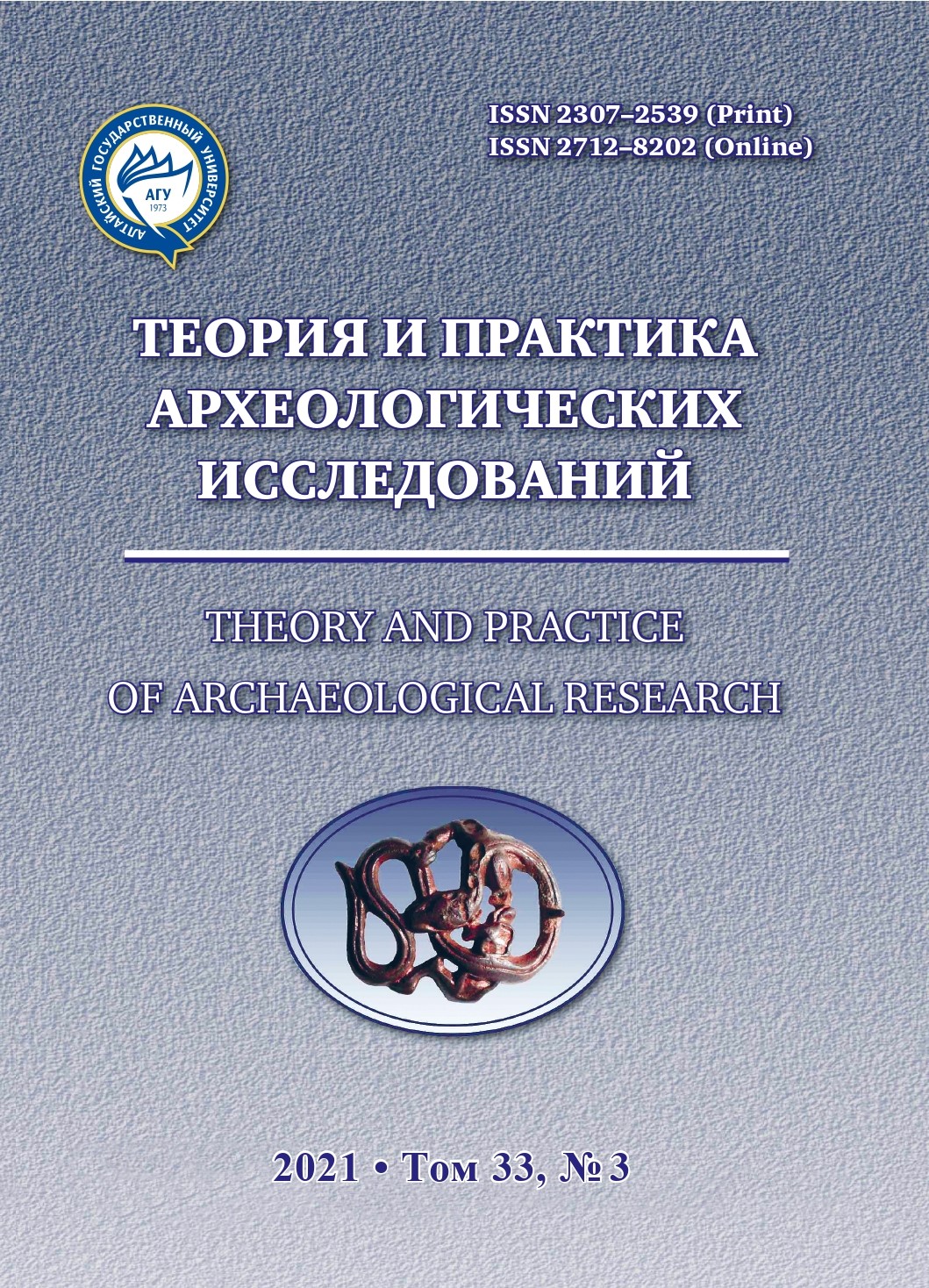EMERGENCE OF MICROLITHIC PRODUCTION IN MONGOLIA: RESEARCH TERMINOLOGY AND CHRONSTRATIGRAPHIC POSITION OF LITHIC INDUSTRIES IN EASTERN AND SOUTHERN ASIA
Abstract
Territory of Mongolia is situated in the center of Asia, a crossroad of the potential migration routes, that connect different Eurasian macroregions. Here an example of earliest appearance and long-term existence of small blade and microblade production has been found. Beyond that, the industries, that appeared within limited area of the Middle Selenga Basin in the late MIS3 — early MIS2, contained the earliest for Northern and Central Asia geometric and non-geometric microliths. They have been found in the sediments of Kharganyn Gol 5 and Tolbor-4, — 16 and –21. They end up in LGM — post-LGM which cause depopulation in the region and following changes in the human groups, occupying this territory. An understanding of the character, causes and specifics of such early appearance of the microblade and bladelet production, and especially geometric microliths, impose the arrangement and definition of the terminology, associated with microlithic assemblages in Asia. This is due to the fact that in the archaeological definitions of both processes and the desired forms of artifacts associated with the production and use of microliths, there are significant discrepancies that complicate the understanding of the described phenomena. The article provides an overview of the research terminology of microlithization processes, and also determines the position of the microlithic complexes of Mongolia in the Upper Paleolithic system of the eastern part of Asia.
Downloads
Metrics
References
Abramova Z. A. Paleolit Eniseya. Afontovskaya kul’tura. [Paleolithic of Enisey. Afontova Culture]. Novosibirsk : Nauka, 1979. 156 p. (In Russ.)
Akimova E. V. Rannesartanskaya industriya melkih plastin v finale pozdnego paleolita Srednego Eniseya: k probleme formirovaniya arheologicheskih refugiumov [Early Sartan Small Blade Industry in the Final Late Paleolithic of Middle Yenisei: the Problem of Archaeological Refugium Forming]. Problemy biologicheskoj i kulturnoj adaptacii chelovecheskih populyacij. T. 1: Arheologiya. Adaptacionnye strategii drevnego naseleniya Severnoj Evrazii: syr’e i priyomy obrabotki [Problems of Biological and Cultural Adaptation of Human Populations. Vol. 1: Archaeology. Adaptation Strategies of the Ancient Population of Northern Eurasia: Raw Materials and Processing Techniques]. SPb. : Nauka, 2008. Pp. 37–47. (In Russ.)
An Zh. The Mesolithic Remains in Hailar — Also on the the Origin and the Tradition of Microliths. Kaogu Xuebao (Chinese Journal of Archaeology). 1978. Vol. 3. Pp. 289–316.
Belfer-Cohen A., Goring-Morris A. N. Why Nicroliths? Microlithization in the Levant. Thinking Small: Global Per-spectives on Microlithic Technologies. Arlington : AP3A, 2002. Pp. 57–68.
Blinkhorn J. Buddha Pushkar Revisited: Technological Variability in Late Palaeolithic Stone Tools at the Thar Desert Margin, India. Journal of Archaeological Science: Reports. 2018. Vol. 20. Pp. 168–182.
Boëda E., Bonilauri S. The Intermediate Paleolithic : the First Bladelet Production 40,000 Years Ago. Anthropologie-International Journal of Human Diversity and Evolution. 2006. Vol.44 (1). Pp. 75–92.
Boëda E., Bonilauri S., Kaltnecker E., Valladas H., Al-Sakhel H. Un débitage lamellaire au Proche-Orient vers 40 000 ans cal BP. Le site d’Umm el Tlel, Syrie central // L’anthropologie. 2015. Vol. 119. Pp. 141–169.
Bon. F. A Brief Overview of Aurignacian Cultures in the Context of the Industries of the Transition from the Middle to the Upper Paleolithic. Towards a Definition of the Aurignacian. Lisbon: Instituto Português de Arqueologia (Trabalhos de Arqueologia 45). 2006. Pp. 133–144.
Brunet, F. The Technique of Pressure Knapping in Central Asia: Innovation or Diffusion? The Emergence of Pressure Blade Making: From Origin to Modern Experimentation. Québec : Springer, 2012. Pp. 307–328.
Chen Ch., Wang X.–Q. Upper Paleolithic Microblade Industries in North China and Their Relationships with Northeast Asia and North America. Arctic Anthropology. 1989. Vol. 2(26). Pp. 127–156.
Clarkson C., Hiscock P., Mackay A., Shipton C. Small, Sharp, and Standardized: Global Convergence in Backed-Microlith Technology. Convergent Evolution in Stone-Tool Technology. Cambridge : MIT Press, 2018. Pp. 175–200.
Clarkson C., Petraglia M., Korisettar R., Haslam M., Boivin N., Crowther A., et al. The Oldest and Longest Enduring Microlithic Sequence in India: 35 000 Years of Modern Human Occupation and Change at the Jwalapuram Locality 9 Rockshelter. Antiquity. 2009. Vol. 83(320). Pp. 326–348.
Derevianko A. P., Petrin V. T., Rybin E. P., Chevalkov L. M. Paleoliticheskie komplexy stratificirovannoy chasti stoyanki Kara-Bom (mustye i verkhniy paleolit) [Paleolithic Complexes of the Stratified Part of the Kara-Bom Site Mousterian/Upper Paleolithic]. Novosibirsk : IAET, 1998. 235 p. (In Russ., English, French).
Derevianko A. P., Zenin A. N., Rybin E. P., Gladyshev S. A., Tsybankov A. A., Olsen J. W., Tseveendorj D., Gunchinsuren, B. The Technology of Early Upper Paleolithic Lithic Reduction in Northern Mongolia: the Tolbor-4 site. Archaeology, Ethnology and Anthropology of Eurasia. 2007. Vol. 29. Pp. 16–38.
Faivre J.-Ph. A Material Anecdote but Technical Reality: Bladelet and Small Blade Production during the Recent Middle Paleolithic at Combe-Grenal Rock Shelter. Lithic Technology. 2012. Vol. 37. Pp. 5–25.
Gladyshev S. A. Svidetel’stva primeneniya tehniki mikrorasshchepleniya v kompleksah rannego verhnego paleolita mnogoslojnyh stratificirovannyh stoyanok Gobijskogo Altaya [Evidence of Micropercussion Technique in the Complexes of the Early Upper Paleolithic at the Multilayered Stratified Sites in the Gobi Altai]. Problemy arheologii, etnografii, antropologii Sibiri i sopredel’nyh territorij [Problems of Archaeology, Ethnography and Anthropology of Siberia and Neighboring territories]. Novosibirsk : Izd-vo In-ta arheologii i etnografii SO RAN, 2017. Vol. 23. Pp. 202–205 (In Russ.).
Gladyshev S. A., Tabarev A. V. Nekotorye problemy izucheniya mikroplastinchatogo rasshchepleniya v rannem verhnem paleolite Severnoj Mongolii [Some Problems of Studies of Microblade Percussion in the Early Upper Paleolithic of Norhtern Mongolia]. Teoriya i praktika arheologicheskih issledovanij [Theory and Practice of Archaeological Research]. 2017. Vol. 17 (1). Pp. 154–166. (In Russ.)
Gladyshev S. А., Tabarev А. V. Mikroplastinchatoe rasshcheplenie v rannem verhnem paleolite Mongolii [Microblade Production in the Early Upper Paleolithic of Mongolia]. Stratum Plus : Archaeology and Cultural Anthropology. 2018. No. 1. Pp. 339–351. (In Russ.)
Gómez Coutouly Y. A. The emergence of pressure knapping microblade technology in Northeast Asia. Radiocarbon. 2018. Vol. 60. Pp. 821–855.
Inizan M.-L., Reduron-Ballinger M., Roche H., Tixier J. Technology and Terminology of Knapped Stone. Nanterre : C.R.E.P., 1999. 191 p.
Keates S. G., Postnov A. V., Kuzmin, Y. V. Towards the Origin of Microblade Technology in Northeastern Asia. Vestnik of Saint Petersburg University. History. 2019. Vol. 64. Pp. 390–414.
Kharevich V. M., Akimova E. V., Stasyuk I. V., Tomilova E. A. Tehnologiya proizvodstva plastin v kamennoj industrii kul’turnogo sloya 19 stoyanki Listvenka [Blade Production Technology in the Industry of Layer 19 of the Listvenka Site]. Stratum Plus. Cultural Anthropology and Archaeology. 2015. No. 1. Pp. 321–331. (In Russ.)
Kolobova K. A., Flas D., Derevianko A. P., Pavlenok K. K., Islamov U. I., Krivoshapkin A. I. The Kulbulak Bladelet Tradition in The Upper Paleolithic of Central Asia. Archaeology, Ethnology and Anthropology of Eurasia. 2013. Vol. 41 (2). Pp. 2–25. https://doi.org/10.1016/j.aeae.2013.11.002.
Kolobova K. A., Krivoshapkin A. I., Derevyanko A. P., Islamov U. I. Dodekatym-2 Paleolithic site (Uzbekistan) // Archaeology, Ethnology, and Anthropology of Eurasia. 2011. Vol. 48 (4). Pp. 2–12.
Krivoshapkin A., Kuzmin Y., Jull A. J. Chronology of the Obi-Rakhmat Grotto (Uzbekistan): First Results on the Dating and Problems of the Paleolithic Key Site in Central Asia // Radiocarbon. 2010. Vol. 52 (2–3). Рp. 549–554.
Kuhn S., Elston R. G. Introduction: Thinking Small Globally. Thinking Small: Global Perspectives on Microlithization. Archaeological Paper No. 12. Washington : American Anthropological Association, 2002. Pp. 1–8.
Lisitsyn N. F. Pozdnij paleolit Chulymo-Enisejskogo mezhdurech’ya [Late Paleolithic of Chulym-Enisej Interfluve]. Trudy IIMK RAN [Proceedings of the IIMK RAN]. Sankt-Petersburg : Peterb. vostokovedenie, 2000. Vol. 2. 230 p. (In Russ.)
Lisitsyn N. F. Srednij etap pozdnego paleolita Sibiri [Middle Stage of Siberian Late Paleolithic]. Rossijskaya arheologiya. 1996. No4. Pp. 5–17. (In Russ.)
Mao X., Zhang H., Qiao S., Liu Y., Chang F., Xie P., Zhang M., Wang T., Li M., Cao P., Yang R., Liu F., Dai Q., Feng X., Ping W., Lei C., Olsen J. W., Bennett E. A., Fu Q. The Deep Population History of Northern East Asia from the Late Pleistocene to the Holocene. Cell. 2021. Vol. 184. Pp. 1–11. https://doi.org/10.1016/j.cell.2021.04.040.
Mellars P. Why Did Modern Human Populations Disperse from Africa 60,000 Years Ago? A New Model. Proceedings of the National Academy of Sciences. 2006. Vol. 103. P. 9381.
Mishra S., Chauhan N., Singhvi A. K. Continuity of Microblade Technology in the Indian Subcontinent Since 45 ka: Implications for the Dispersal of Modern Humans. PLoS ONE. 2013. Vol. 8(7) Pp. e69280. https://doi.org/10.1371/journal.pone.0069280
Morlan R. E. Wedge-shaped Core Technology in Northern North America. Arctic Anthropology. 1970. Vol. 7(2). Pp. 17–37.
Nakazawa Y., Akai F. Late-Glacial Bifacial Microblade Core Technologies in Hokkaido: An Implication of Human Adaptation along the Northern Pacific Rim. Quaternary International. 2017. Vol. 442. Pp. 43–54. https://doi: 10.1016/j.quaint.2016.07.019.
Nakazawa Y., Izuho M., Takakura J., Yamada S. Toward an Understanding of Technological Variability in Microblade Assemblages in Hokkaido. Japan. Asian Perspectives. 2005. Vol. 44. Pp. 276–292.
Pargeter J. Lithic Miniaturization in Late Pleistocene Southern Africa. Journal of Archaeological Science: Reports. 2016. Vol. 1010. Pp. 221–236.
Pastoors A., Tafelmaier Y. Bladelet Production, Core Reduction Strategies, and Efficiency of Core Configuration at the Middle Palaeolithic site Balver Höhle (North Rhine Westphalia, Germany). Quartär. 2010. Vol. 57. Pp. 25–41.
Pavlenok G. D. Tehnologiya izgotovleniya klinovidnyh nukleusov v selenginskoj kul’ture Zapadnogo Zabajkal’ya (po materialam stoyanki Ust’-Kyahta-3) [Technology of Wedge-Shaped Cores Production in the Selenga Culture of Western Tansbaikalia]. Izvestiya Altajskogo gosudarstvennogo universiteta. Ser.: Istoricheskie nauki i arheologiya. 2015. No. 3/2 (87). Pp. 178–184. (In Russ.)
Pelegrin J. Blade Making Techniques from the Old World: Insights and Applications to Mesoamerican Obsidian Lithic Technology. Mesoamerican Lithic Technology: Experimentation and Interpretation. Salt Lake City : The University of Utah Press, 2003. Pp. 55–71.
Rybin E. P., Khatsenovich A. M., Zwins N., Gunchinsurehn B., Paine С., Bolorbat Ts., Anojkin A. A., Kharevich V. M., Odsuren D., Margad-Erdene G. Stratigrafiya i kul’turnaya posledovatel’nost’ stoyanki Tolbor-21 (Severnaya Mongoliya): itogi rabot 2014–2016 godov i dal’nejshie perspektivy issledovanij [Stratigraphy and Cultural Sequence of the Tolbor 21 Site (Northern Mongolia): the Results of the 2014–2016 Excavation Campaigns and Perspectives of Further Investigations]. Teoriya i praktika arheologicheskih issledovanij [Theory and Practice of Archaeological Research]. 2017. Vol. 15. No. 4 (20). Pp. 158–168. (In Russ.)
Sato H., Tsutsumi T. The Japanese Microblade Industries: Technology, Raw Material Procurement, and Adaptations. Origin and Spread of Microblade Technology in Northern Asia and North America. Burnaby (BC) : Archaeology Press, Simon Fraser University, 2007. Pp. 57–78.
Sollberger J. B., Patterson L. W. Prismatic Blade Replication. American Antiquity. 1976. Vol. 41. Pp. 517–531.
Song Y., Grimaldi S., Santaniello F., Cohen D. J., Shi J., Bar-Yosef O. Re-thinking the Evolution of Microblade Technology in East Asia: Techno-Functional Understanding of the Lithic Assemblage from Shizitan 29 (Shanxi, China). PLoS One. 2019. Vol. 14 (2). P. e0212643.
Soriano S., Villa P., Wadley L. Blade Technology and Tool Forms in the Middle Stone Age of South Africa: the Howiesons Poort and Post-Howiesons Poort at Rose Cottage Cave. Journal of Archaeological Science. 2007. Vol. 34 (2007). Pp. 681–703.
Takakura J. Emergence and Development of the Pressure Microblade Production: a View from the Upper Paleolithic of Northern Japan. The Emergence of Pressure Blade Making. Québec : Springer, 2012. Pp. 285–306.
Taylor W. E. A Distinction between Blades and Microblades in the American Arctic. American Antiquity. 1962. Vol. 27. Pp. 425–426.
Tixier J. Typologie de l’Epipaléolithique du Maghreb. Mémoires du Centre de Recherches anthropologiques et préhistoriques et ethnographiques 2. Paris : Arts et Métiers graphiques,1963. 212 p.
Wedage O., Picin A., Blinkhorn J., Douka K., Deraniyagala S., Kourampas N., Perera N., Simpson I., Boivin N., Petraglia M., Roberts P. Microliths in the South Asian Rainforest~45–4 ka: New Insights from Fa-Hien Lena Cave, Sri Lanka. PLoS ONE. 2019. Vol. 14(10).P. e0222606. https://doi.org/10.1371/journal.pone.0222606
Zwyns N., Gladyshev S. A., Gunchinsuren B., Bolorbat T., Flas D., Tabarev A. V., Dogandzic T., Gillam G. C., Khatsenovich A. M., Odsuren D., Purevjal K.‐E., Richards M., Stewart J., Talamo S. The Open-Air Site of Tolbor 16 (Northern Mongolia): Preliminary Results and Perspectives. Quaternary International. 2014. Vol. 347. Pp. 53–65.
Zwyns N., Rybin E. P., Hublin J.‐J., Derevianko A. P. Burin-Core Technology and Laminar Reduction Sequence in the Initial Upper Paleolithic from Kara-Bom (Gorny-Altai, Siberia).Quaternary International. 2012. Vol. 259. P. 33–47.
Theory and Practice of Archaeological Research is a golden publisher, as we allow self-archiving, but most importantly we are fully transparent about your rights.
Authors may present and discuss their findings ahead of publication: at biological or scientific conferences, on preprint servers, in public databases, and in blogs, wikis, tweets, and other informal communication channels.
Theory and Practice of Archaeological Research allows authors to deposit manuscripts (currently under review or those for intended submission to ABS) in non-commercial, pre-print servers such as ArXiv.
Authors who publish with this journal agree to the following terms:
- Authors retain copyright and grant the journal right of first publication with the work simultaneously licensed under a Creative Commons Attribution License (CC BY 4.0) that allows others to share the work with an acknowledgement of the work's authorship and initial publication in this journal.
- Authors are able to enter into separate, additional contractual arrangements for the non-exclusive distribution of the journal's published version of the work (e.g., post it to an institutional repository or publish it in a book), with an acknowledgement of its initial publication in this journal.
- Authors are permitted and encouraged to post their work online (e.g., in institutional repositories or on their website) prior to and during the submission process, as it can lead to productive exchanges, as well as earlier and greater citation of published work (See The Effect of Open Access).








2.jpg)



